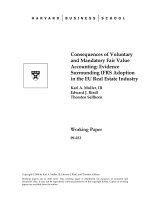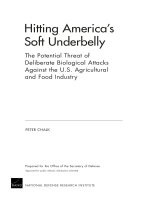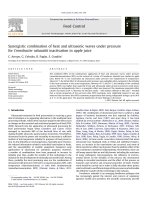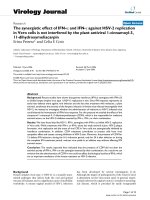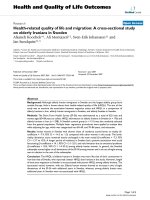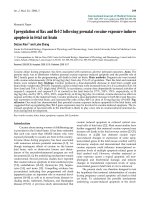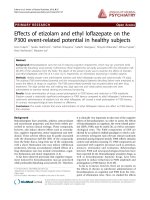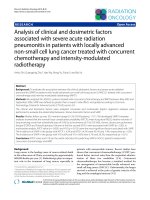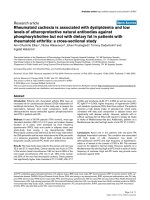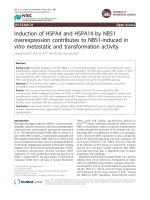Virulence of steinernima and heterorhabditis against black cutworm, Agrotis segetum (Lepidoptera: Noctuidae) in potato crop
Bạn đang xem bản rút gọn của tài liệu. Xem và tải ngay bản đầy đủ của tài liệu tại đây (185.7 KB, 6 trang )
Int.J.Curr.Microbiol.App.Sci (2019) 8(2): 2404-2409
International Journal of Current Microbiology and Applied Sciences
ISSN: 2319-7706 Volume 8 Number 02 (2019)
Journal homepage:
Original Research Article
/>
Virulence of Steinernima and Heterorhabditis against black Cutworm,
Agrotis segetum (Lepidoptera: Noctuidae) in Potato Crop
Neelam Kumari1*, Deepak C. Kalia1 and V.K. Chandla2
1
Department of Bio-sciences, Himachal Pradesh University Shimla, India
2
Department of Plant Protection, ICAR- CRRI Shimla, India
*Corresponding author
ABSTRACT
Keywords
Steinernima and
Heterorhabditis
black Cutworm,
Agrotis segetum
Article Info
Accepted:
18 January 2019
Available Online:
10 February 2019
The common cutworm (turnip moth) Agrotis segetum (Denis & Schiffermuller) is nearly
cosmopolitan insect pest of potato. The efficacy of the entomopathogenic nematodes
(EPN) Steinernema carpocapsae and Heterorhabditis indica was evaluated against
different developmental stages of A. segetum under laboratory conditions. In laboratory
studies, significant mortality of second instar larvae was recorded by H. indica (73.3-100
per cent) and 63.3-100 per cent by S. carpocapsae after 48 hrs of treatment at EPNs
suspension of 50-300 IJs/ml (1 ml per larva). In the preliminary bioassay study, all the
tested EPNs were capable to cause maximum mortality within three to five days of
treatment. The highest mortality (100 per cent) of fourth instar larvae and pupae was
observed at more than 200 IJs/ml nematodes suspension of S. carpocapsae and H. indica
after five days of treatment. At nematodes suspension 50 IJs/ml, 56.7 per cent mortality of
fourth instar was recorded by S. carpocapsae and 76.7 per cent by H. indica after five days
of treatment. The pupae of A. segetum were less susceptible to EPNs infections as
compared to larvae due to reduced number of portal entries.
Introduction
Among soil pests, Agrotis segetum (Denis &
Schiffermueller)
belonging
to
family
Noctuidae and order Lepidoptera, is the major
pest of potato in Himachal Pradesh. The
cutworms (larvae of Agrotis spp.) cut off the
tender stalks of young plants of potato at their
bases or a few centimeters above the ground
during night and feed on them. Sometimes,
heavily infested fields look as if they have
been grazed and losses caused by them during
epidemic year cross over 30 per cent
(Chaudhary, 1953). In young crops, cutworms
usually damage tender shoots and branches.
However, after tuberisation their damage is
confined to tubers in standing crop. The five
species of cutworm viz., A. ipsilon
(Hufnagal), A. interacta (Walk.), A.
flammatra (Denis & Schiffermueller), A.
spinnifera (Hufnagal) and A. segetum (Denis
& Schiffermueller) have been reported on
potato crop (Chaudhary, 1953 and Nirula,
1961). Saxena and Misra (1983) reported 12
per cent tuber damage in potato crop by
cutworm in Shimla (India).
2404
Int.J.Curr.Microbiol.App.Sci (2019) 8(2): 2404-2409
At present, synthetic insecticides are the
primary means for the control of cutworms.
But due to the implementation of the Food
Quality Protection Act, it has become
necessary to look forward towards the
biological control measures for the
management of cutworm. There are many
factors that in theory make entomopathogen
nematodes (EPN) the ideal biological control
agents. Entomopathogenic nematodes (EPNs)
of the families Steinernematidae and
Heterorhabditidae are widely distributed in
soils throughout the world. Additionally,
some species of nematodes can actively seek
out their hosts and kill them rapidly. The
studies on evaluation of effectiveness of these
nematodes in potato crop in the mid and
higher hills of Himachal Pradesh were
limited.
In
the
present
study
entomopathogenic nematodes, S. carpocapsae
and H. indica were evaluated against
cutworms (second, fourth instar larvae and
pupae) in laboratory conditions.
Materials and Methods
Procurement and Mass Multiplication of
EPN Entomopathogen nematodes
The
entomopathofenic
nematodes,
S.
carpocapsae and H. indica were procured
from Protect Directorate of Biological Control
(PDBC), Bangalore, India. The waxworm,
Galleria mellonella is the insect of choice for
in vivo production because it is produced
commercially in large numbers (Ehlers R.,
2001). The basic method for small-scale
production is described in Kaya and Stock
(1997). White trap having inverted watch
glass (60mm) placed in Petri dish (150 × 20
mm) and filled with 15 ml sterile water. A
moist filter paper placed on watch glass. G.
mallonella cadavers are placed onto this filter
paper. After two week days infective
juveniles (IJ) started emerging from the
cadavers and migrated into the water of Petri
dish. IJ are the third stage juveniles of
entomopathogenic nematodes and only this
infective stage of EPN is capable of surviving
outside the host and moving from one insect
to another.
Laboratory bioassay
Larval mortality bio-assays were carried out
in petri dishes (35 x 10 mm) lined with double
layer of Whatman no. 1 filter paper (Kaya and
Stock (1997). The nematode suspensions of
50 to 300 infective juveniles (IJs) in 1 ml of
deionized water were added to the filter paper
in petri plates. Control plates were treated
with distilled water only. Five replicates were
considered for each treatment and Petri dishes
were kept at 27 ± 1 °C. Dead larvae were
recognized according to change in their body
color. Cadavers were transferred to White trap
to confirm nematode infection. The
experiment was repeated thrice. The untreated
controls were identical to the treatment except
that no IJs were added. The larval mortality
was recorded at every 24 hrs for a week. The
cause of larval death was confirmed by
change in body colour of the cadaver due to
symbiotic bacteria. The raw values were
square root transformed and percent data were
arcsine transformed. All data were subjected
to the one-way ANOVA. Mean difference
was tested using Duncan’s multiple range test
(DMRT). MSTAT-C software was used for
analysis.
Results and Discussion
Bioassay of EPNs against 2nd instar
cutworm, A. segetum
The study on per cent mortality of second
instar cutworm at EPNs suspension of 50-300
IJs/ml (1 ml per larva) showed 73.3-100 per
cent mortality by H. indica followed by 63.3100 per cent by S. carpocapsae after 48 hrs of
treatment. The mortality increased with
2405
Int.J.Curr.Microbiol.App.Sci (2019) 8(2): 2404-2409
increased in the numbers of EPNs from 50300 IJs/ml. At nematodes suspension of 50
IJs/ml, 63.3 per cent by S. carpocapsae after
48 hrs of treatment (Fig. 1), whereas 73.3 per
cent was recorded by H. indica (Fig. 2). At
nematodes suspension of 100 IJs/ml,
maximum mortality (96.6 per cent) was
observed by H. indica which was followed
80.0 per cent by S. carpocapsae, whereas
maximum mortality (100 per cent) was found
at nematodes suspension more than 200
IJs/ml in all the treatments. Among all the
treatments, H. indica proved as most effective
one due to the presence of dorsal tooth that
can locate the host plant easily and caused
early mortalilty of target pests. The results are
in agreement with Hussaini (1980), who
reported that the infective juveniles of
Heterorhabditis spp. gained entry by abrading
the inter-segmental membranes of the insect
by using dorsal tooth (Table 1).
Preliminary bioassay of EPNs on 4th instars
cutworm and pupae, A. segetum
The highest mortality (100 per cent) of fourth
instar larvae and pupae was observed at more
than 200 IJs/ml nematodes suspension of S.
carpocapsae and H. indica after five days of
treatment. At nematodes suspension 50
IJs/ml,, 56.7 and 76.7 per cent mortality was
recorded respectively, S. carpocapsae and H.
indica after five days of treatment. At
nematodes suspension 100 IJs/ml, 70.0 and
83.3 per cent mortality was recorded
respectively, S. carpocapsae and H. indica at
five days of treatment (Table 2).
The pupae of A. segetum were less susceptible
to EPNs infections as compared to larvae due
to reduced number of portal entries. At
nematodes suspension 200 IJs/ml, 86.7 and
93.6 per cent mortality of pupae was recorded
in S. carpocapsae and H. indica respectively
as compared to control (3.33-6.67 per cent)
(Table 2). Kaya and Gangler (1993) also
reported that the pupae were less susceptible
to nematodes infections than the larvae
because of the reducing numbers of the portal
entries. Ebsaa and Koppenhofer (2011)
reported the efficacy of commercial products
containing the entomopathogenic nematodes
H. bacteriophora, S. carpocapsae, S. feltiae
and S. riobrave against fourth instar black
cutworm. The results are in agreement with
the findings of Badr et al., (2009),
investigated the effects of entomopathogenic
nematodes, S. carpocapsae and H. indica
against A. ipsilon, this study proved that S.
carpocapsae and H. indica were highly
virulent at nematodes suspension of 100
IJs/ml that caused 100 per cent mortality of
third
instar
larvae
and
pupae.
Table.1 Susceptibility of 2nd instar larvae of A. segetum to different concentrations of EPNs
(IJs/ ml)
50
100
200
250
300
Control
S.Em.±
C.D.(0.05)
Mortality % ( 48 hrs)
Sc
63.3 (52.73)
80.0 (63.46)
93.3 (75.03)
100( 90.04)
100 (90.04)
0.0 (0.0)
2.01
8.78
Hb
73.3 (58.91)
96.6 (79.41)
100 (90.04)
100 (90.04)
100 (90.04)
6.67 (14.91)
2.35
6.35
Figures in parentheses are arc sine transformed values; Sc = S. carpocapsae; Hb = H. indica
2406
Int.J.Curr.Microbiol.App.Sci (2019) 8(2): 2404-2409
Table.2 Susceptibility of 4th instar larvae and pupae of A. segetum to different concentrations of
EPNs
Nematode
Concentrations
(IJs/ larvae)
50
100
200
250
300
Control
S.Em.±
C.D.(0.05)
Mortality % (5 DAT)
Larvae
Pupae
Sc
56.7
(48.47)
70.0
(56.81)
90.0
(71.60)
100.0
(90.04)
100.0
(90.04)
0.00
(0.0)
1.70
5.25
Hb
76.7
(61.14)
83.3
(65.91)
96.7
(79.57)
100.0
(90.04)
100.0
(90.04)
3.33
(10.51)
2.30
7.08
Sc
50.0
(45.02)
60.0
(50.79)
86.7
(68.64)
100.0
(90.04)
100.0
(90.04)
0.00
(0.0)
1.25
3.88
Hb
63.3
(52.73)
76.7
(61.16)
93.3
(75.03)
100.0
(90.04)
100.0
(90.04)
6.67
(14.97)
3.64
9.37
Fig.1 The percentage mortality of 2nd instar larvae of A. segetum by different concentrations of
infective juveniles of S. carpocapsae (Sc)
2407
Int.J.Curr.Microbiol.App.Sci (2019) 8(2): 2404-2409
Fig.2 The percentage mortality of 2nd instar larvae of A. segetum through different
concentrations of infective juveniles of H. indica (Hb)
Hussaini (1980) reported the efficacy of
different formulations (talc based, alginate
capsules and water) of S. carpocapsae, S.
abbasi and H. indica against A. ipsilon in a
filter paper and soil assay. The results showed
that alginate formulations caused the
maximum mortality of 33-47 per cent and 6080 per cent after 96 hrs for the filter paper and
soil assay, respectively. The survival of
infective juveniles was highest in water
followed by talc and alginate for Steinernema
spp. The larval mortality of target pests was
due to the toxin released by the symbiotic
bacteria associated with the EPNs inside the
haemocoel of insect’s larvae. Hussaini (1980)
also reported that once in the haemocoel of
the insect the infective juveniles released cells
of the symbiotic bacterium (Xenorhabdus spp.
for Steinernema spp. and Photorhabdus spp.
for Heterorhabditis spp.) which it carried in
its intestine. The insect haemolymph provided
rich nutrients medium for the bacterial growth
and these bacteria released toxins/
exoenzymes, which killed the insect through
septicemia. Divya, K and Sankar M (2009)
proved that EPN H. indica is a potential
option for possible management, capable of
nematode production with efficacy notable
against cotton bollworm, Helicoverpa
armigera and tobacco caterpillar, Spodoptera
litura.
EPNs have been successfully employed as
efficient biocontrol agents against the larvae
of some noctuids, including A. ipsilon
(Hufnagel) and A. segetum in some Asian or
European countries (Georgis et al., 2006;
Kaya et al., 2006; Lacey & Georgis, 2012).
The study provides evidence that S.
carpocapsae and H. indica under controlled
laboratory conditions are able to exert an
excellent degree of control over different
stages of A. segetum. It is therefore
recommended
that
entomopathogenic
nematodes, S. carpocapsae and H. indica
could be used as one of the best bio-control
agent for the bio-intensive management of
cutworms in potato crop.
2408
Int.J.Curr.Microbiol.App.Sci (2019) 8(2): 2404-2409
References
Badr, E. L., Sahah, A., Amaani, F., Khaled, S.
and Thorasa, F. K. 2009. Combined
effects of entomopathogenic nematodes
and bio-pesticides to control the greasy
cutworm, Agrotis ipsilon (Hufn.) in the
fields of strawberry. Journal of
Biological Sciences 2(1): 227-236.
Chaudhary, R. P. 1953. Control of cutworm in
potato fields. Indian Journal of
Entomology 15(3): 203-206.
Divya, K., and Sankar M. 2009.
Entomopathogenic nematodes in pest
management. Indian Journal of Science
and Technology 2, 53-60.
Divya, K., Sankar, M. and Marulasiddesha,
K.N.
2011.
Efficacy
of
entomopathogenic
nematodes,
Heterorhabditis indica against three
lepidopteran pests. Asian Journal of
Experimental Biology and Science 1
(1): 183-188.
Ebsaa, L., and Koppenhofer, M. 2011.
Efficacy
and
persistence
of
entomopathogenic nematodes for black
cutworm control in turfgrass. Biocontrol Science and Technology 21(7):
779-796.
Ehlers R. 2001. Mass production of
entomopathogenic nematodes for plant
protection.
Applied
Microbiology
Technology 56, 623-633.
Georgis, R., Koppenhöfer A.M., Lacey L.A.,
Belair G., Duncan L.W, Grewal P.S.,
Samish M., Tan L., Torr P. and Van Tol
R.W.H.M. 2006. Successes and failures
in the use of parasitic nematodes for
pest control. Biological Control 38:
103–123.
Hussaini, S. S. 1980. Potential of
Entomopathogenic nematodes for pest
control. In: Bio-pest Management. Eds.
Gupta, H. C. L. and Siddiqui, A.U.
Agrotech
Publication
Academy,
Udaipur, 13-39.
Kaya, H. and Stock, S. 1997. Techniques in
insect nematology. In: Biological
Techniques: Manual of techniques in
insect pathology. Eds. Lacey, L.
Academic Press, Millbrae, California,
USA, 281-324.
Kaya, H.K., M.M. Aguillera, A. Alumai, H.Y.
Choo, M. De la Torre, A. Fodor, S.
Ganguly, S. Hazır, T. Lakatos, A. Pye,
M. Wilson, S. Yamanaka, H. Yangm &
R.-U. Ehlers, 2006. Status of
entomopathogenic nematodes and their
symbiotic bacteria from selected
countries or regions of the world.
Biological control 38: 134–155.
Lacey, L.A. & R. Georgis, 2012.
Entomopathogenic
nematodes
for
control of insect pests above and below
ground with comments on commercial
production. Journal of Nematology 44:
218–225.
Nirula, K. K. 1961. Insecticidal control of
Agrotis ypsilon Rott. Indian Potato
Journal 3(1): 42-47.
Saxena, A. P. and Misra, S. S. 1983. Pests of
potato crop in high altitude and their
control. In: Proceeding and Workshop
on High Altitude Entomology and Wild
life Economics, Solan, India, Pp. 165180.
How to cite this article:
Neelam Kumari, Deepak C. Kalia and Chandla, V.K. 2019. Virulence of Steinernima and
Heterorhabditis against black Cutworm, Agrotis segetum (Lepidoptera: Noctuidae) in Potato
Crop. Int.J.Curr.Microbiol.App.Sci. 8(02): 2404-2409.
doi: />
2409
